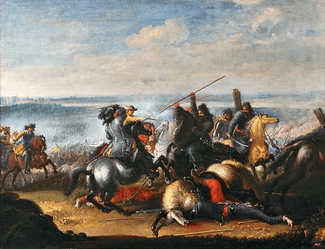Battle of Warsaw (1656)
| Battle of Warsaw | |||||||
|---|---|---|---|---|---|---|---|
| Part of Second Northern War / The Deluge | |||||||
 Swedish king Charles X Gustav in skirmish with Polish Tartars near Warsaw 1656 | |||||||
| |||||||
| Belligerents | |||||||
|
|
| ||||||
| Commanders and leaders | |||||||
|
|
| ||||||
| Strength | |||||||
|
9,500 Swedish 8,500 Prussians Total: 18,000:[1]:174 5,500 infantry 12,500 cavalry |
36,000-39,000 Polish-Lithuanian 2,000 Crimean Tatars[2] Total: about 40,000:[1]:173 4,500 infantry 35,500 cavalry | ||||||
| Casualties and losses | |||||||
| between 700[3] and 1,300 men[4] | between 2,000[5] and 4,000 men[6] | ||||||
The Battle of Warsaw (German: Schlacht von Warschau; Polish: Bitwa pod Warszawą; Swedish: Tredagarsslaget vid Warszawa) was a battle which took place near Warsaw on July 28–July 30 [O.S. July 18–20] 1656, between the armies of the Polish-Lithuanian Commonwealth and Sweden and Brandenburg. It was a major battle in the Second Northern War between Poland and Sweden in the period 1655–1660, also known as The Deluge. According to Hajo Holborn, it marked "the beginning of Prussian military history".[7]
In the battle, a smaller Swedish-Brandenburg force gained victory over a Polish-Lithuanian force superior in numbers, though in the long term the victory achieved little. Polish-Lithuanian losses were insignificant, since the Polish noble levy promptly retreated from the battlefield.
Prelude
The Polish-Lithuanian forces, commanded by King John II Casimir of Poland, comprised about 24-25,000 regulars, which included only 950 Winged Hussars - 8 banners), 2,000 Tatars and 10-13,000 of the noble levy (pospolite ruszenie), altogether some 40,000 men of which only about 4,500 were infantry.[1]:173 The allied armies of Sweden and Brandenburg, commanded by King Charles X of Sweden and Elector Frederick William of Brandenburg, were only 18,000 strong, comprising 12,500 cavalry (60 squadrons), and 5,500 infantry (15 brigades), which included 8,500 Brandenburg men.[1]:174 Second in command of Brandenburg's forces was Otto Christoph von Sparr.
John II Casimir ferried his army across the Vistula River[1]:173 and met the approaching Swedish-Brandenburg force on its right bank, about five kilometers to the north of the suburb of Praga. Charles X had initially hoped to destroy the Lithuanian and Tatar forces before they joined up with the remainder of the Commonwealth army, but this plan failed. Some officers of Brandenburg considered the Polish-Lithuanian forces to be overwhelming in numbers and instead advocated a retreat.
First day
Charles marched his allied army down the right (east) bank of the Vistula on 28 July and assaulted the Polish army.[1]:174 However, the Polish infantry had dug into a narrow corridor along the river bank, which prevented them from being dislodged.[1]:174
Second day
Charles, wheeling left, moved his entire army to the Polish right, through the Białołęka Forest onto a narrow plain, consolidating his position before the Polish hussars could react.[1]:174 Aleksander Polbinski's 800 hussars drove into the three lines of cavalry, reiter, guarding the flanks of Charles' infantry.[1]:174 The hussars broke through the first line but were stopped by the second line of Uppland and Smaland regiments.[1]:174 The Cossack cavalry, the pancerna, did not participate in the attack, being held in reserve.[1]:174 Seeing that the Swede-Brandenburg allies held their ground, John II Casimir withdrew his army across the Vistula bridge, covered by his cavalry.[1]:174
Third day

The Swede and Brandenburg allies occupied the open plain and the Polish-Lithuanian cavalry escaped along the Vistula and John Casimir abandoned Warsaw again.[1]:174
Aftermath
The Brandenburg and Swedish allies occupied Radom on 10 Aug., and the Brandenburg garrisons replaced the Swedes in Wielkopolska, but then they refused to support the Swedes any further, forcing Charles to withdraw north to Royal Prussia.[1]:174 John Casimir quickly regrouped at Lublin.[1]:177
The Battle of Warsaw is commemorated on the Tomb of the Unknown Soldier, Warsaw, with the inscription "Warszawa 30 V-1 VII, 28-30 VII 1656".
See also
References
- 1 2 3 4 5 6 7 8 9 10 11 12 13 14 15 Frost, R.I., 2000, The Northern Wars, 1558-1721, Harlow: Pearson Education Limited, ISBN 0582064295
- ↑ Majewski, Andrzej A.: Szarża husarska pod Warszawą 29 lipca 1656 roku {in} Przegląd Historyczno-Wojskowy, 2012, Tom 13 (64), Numer 3 (241) Wojskowe Centrum Edukacji Obywatelskiej w Warszawie, ISSN 1640-6281, S. 167.
- ↑ Curt Jany: History of the Prussian Army - From the 15th century to 1914, Volume 1, Biblio Verlag, Osnabrück 1967, p 130
- ↑ Lars Ericson Wolke, Martin Hårdstedt, Per Iko, Ingvar Sjöblom and Gunnar Åselius: "Svenska slagfält", Wahlström & Widstrand, p. 189
- ↑ Sundberg (2010). Sveriges krig 1630-1814. p. 134
- ↑ Claes-Göran Isacson, Karl X Gustavs Krig (2002) Lund, Historiska Media. pp 72.
- ↑ Holborn, Hajo (1982). A History of Modern Germany: 1648-1840. A History of Modern Germany. 2. Princeton University Press. p. 57. ISBN 0-691-00796-9.
- Citino, Robert M. (2005). The German Way of War: From the Thirty Years' War to the Third Reich. University Press of Kansas. p. 428. ISBN 0-7006-1410-9.
Additional Reading
- Curt Jany: History of the Prussian Army - From the 15th century to 1914, Volume 1, Biblio Verlag, Osnabrück 1967, p 120-130
- Svenska Slagfält, 2003, (Walhlström & Widstrand) ISBN 91-46-21087-3
- Miroslav Nagielski, "Warszawa 1656", Bellona (1990)
- J.Cichowski & A.Szulczynski, "Husaria", MON (1981)
- Leszek Podhorodecki, "Rapier i koncerz", Książka i Wiedza (1985)
External links
| Wikimedia Commons has media related to Battle of Warsaw 1656. |
Coordinates: 52°13′56″N 21°00′30″E / 52.2323°N 21.0084°E